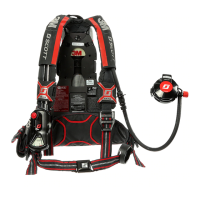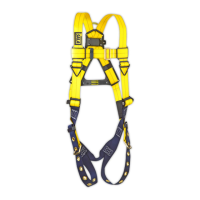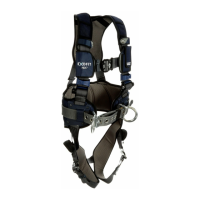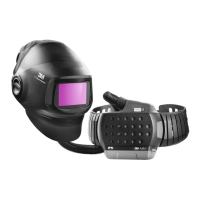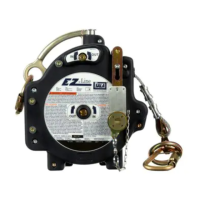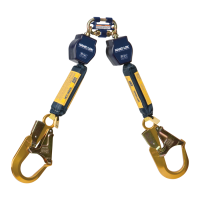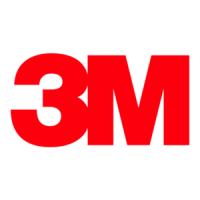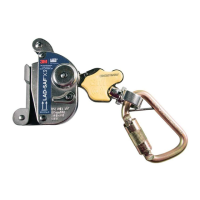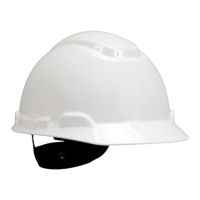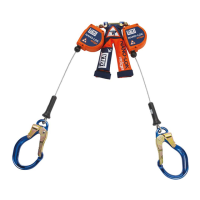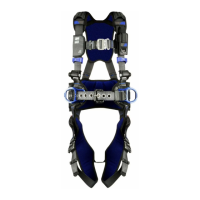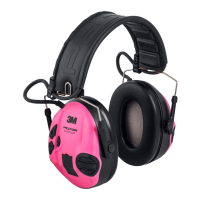P/N 595390-01 Rev B 201910 27
APPENDIX A
FACEPIECE FITTING
A respirator quantitative fit test must be performed to ensure the correct respirator facepiece size has been selected
and assigned to the user. The respiratory protection’s program manager or safety coordinator is responsible for
assisting the user in selecting the correct respirator size relative to the user’s facial features and dimensions. Any
approved 3M Scott Fire & Safety accessories that will be used with the respirator, such as a communications device
installed on the facepiece, must be in place during fit testing. If changing from a standard facepiece to a facepiece
with an installed accessory, such as a communications device, it is recommended that a new fit test be performed.
About Fit Testing
Before occupational use of this respirator, a written respiratory protection program must be implemented meeting all
local, state, and federal government requirements. In the United States, employers must comply with OSHA 29 CFR
1910.134, which includes medical evaluation, training, and fit testing.
Respirator fit tests are explained fully in the following:
• American National Standard Practices for Respiratory Protection, ANSI/AIHA/ASSE Z88.10-2010, which is
published by the American National Standards Institute (ANSI), 11 West 42nd Street, New York, New York, 10036
• Occupational Safety and Health Standards, OSHA 29 CFR 1910.134 Appendix A, which is published by the
Occupational Safety and Health Administration (OSHA), 200 Constitution Avenue, NW, Washington DC, 20210.
Quantitative fit testing per OSHA Standard 29 CFR Part 1910.134 Appendix A, or ANSI/AIHA/ASSE Z88.10-2010,
requires testing in the negative pressure mode using Quantitative Fit Test (QNFT) protocols deemed acceptable by
those standards. For quantitative fit testing, 3M Scott Fire & Safety facepieces require use of the appropriate negative
pressure QNFT test protocol, such as the ambient aerosol condensation nuclei counter (for example, the PortaCount
1
or the Quantifit
2
) and controlled negative pressure (CNP) fit test device along with the following 3M Scott Fire &
Safety products as required to support the selected protocol:
• A new CBRN CAP-1 Canister (P/N 045135) or P100 Cartridge (P/N 052683)
3
• Probed Fit Test Adapter (P/N 201520-01) or equivalent probed facepieces and the full range of sizes and styles
• Mask Seal Kit (P/N 805655-01)
• Appropriate accessory, such as a communications device, properly installed on the facepiece
When using a PortaCount Respirator Fit Tester for quantitative fit testing, TSI recommends that the level of particles
in the ambient air must be between 5000 and 30000 particles/cm
3
. If you have difficulty achieving the minimum
level of ambient particle count required, refer to the PortaCount Respirator Fit Tester user instructions for details
including available Particle Generators to use with the PortaCount Respirator Fit Tester. When using the controlled
negative pressure protocol, model specific adapters must be used. These are provided by the manufacturer of the
controlled negative pressure fit test device.
1. PortaCount is a registered trademark of TSI, Incorporated, St. Paul, MN
2. Quantifit is a registered trademark of OHD, LLLP, Birmingham, AL
3. Depending on whether the user is fit testing for CBRN SCBA Open Circuit mode of operation (minimum Fit Factor
equal to or greater than 500) or CBRN APR (minimum Fit Factor equal to or greater than 2000)
P/N 595390-01
201910
Rev B
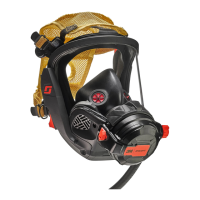
